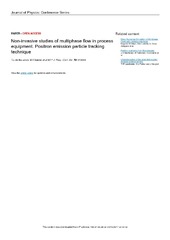| dc.contributor.author | Balakin, Boris | |
| dc.contributor.author | Adamsen, Tom Christian Holm | |
| dc.contributor.author | Chang, Yu-Fen | |
| dc.contributor.author | Kosinski, Pawel Jan | |
| dc.contributor.author | Hoffmann, Alex Christian | |
| dc.date.accessioned | 2017-11-06T12:17:27Z | |
| dc.date.available | 2017-11-06T12:17:27Z | |
| dc.date.issued | 2017 | |
| dc.Published | Balakin BV, Adamsen TCH, Chang Y.-F., Kosinski PJ, Hoffmann AC. Non-invasive studies of multiphase flow in process equipment. Positron emission particle tracking technique.. Journal of Physics, Conference Series. 2017;781:012039 | eng |
| dc.identifier.issn | 1742-6596 | en_US |
| dc.identifier.issn | 1742-6588 | en_US |
| dc.identifier.uri | https://hdl.handle.net/1956/16836 | |
| dc.description.abstract | Positron emission particle tracking (PEPT) is a novel experimental technique for non-invasive inspection of industrial fluid/particle flows. The method is based on the dynamic positioning of a positron-emitting, flowing object (particle) performed through the sensing of annihilation events and subsequent numerical treatment to determine the particle position. The present paper shows an integrated overview of PEPT studies which were carried out using a new PET scanner in the Bergen University Hospital to study multiphase flows in different geometric configurations. | en_US |
| dc.language.iso | eng | eng |
| dc.publisher | IOP | en_US |
| dc.rights | Attribution CC BY | eng |
| dc.rights.uri | http://creativecommons.org/licenses/by/3.0 | eng |
| dc.title | Non-invasive studies of multiphase flow in process equipment. Positron emission particle tracking technique | en_US |
| dc.type | Peer reviewed | |
| dc.type | Journal article | |
| dc.date.updated | 2017-10-06T08:43:06Z | |
| dc.description.version | publishedVersion | en_US |
| dc.identifier.doi | https://doi.org/10.1088/1742-6596/781/1/012039 | |
| dc.identifier.cristin | 1448825 | |
| dc.source.journal | Journal of Physics, Conference Series | |

